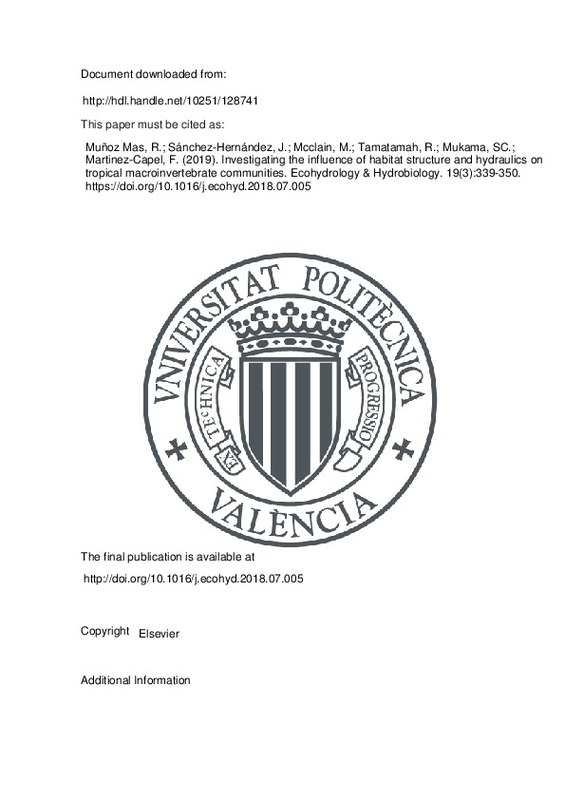JavaScript is disabled for your browser. Some features of this site may not work without it.
Buscar en RiuNet
Listar
Mi cuenta
Estadísticas
Ayuda RiuNet
Admin. UPV
Investigating the influence of habitat structure and hydraulics on tropical macroinvertebrate communities
Mostrar el registro sencillo del ítem
Ficheros en el ítem
| dc.contributor.author | Muñoz Mas, Rafael
|
es_ES |
| dc.contributor.author | Sánchez-Hernández, Javier
|
es_ES |
| dc.contributor.author | McClain, Michael
|
es_ES |
| dc.contributor.author | Tamatamah, Rashid
|
es_ES |
| dc.contributor.author | Mukama, Shelard Chilemeji
|
es_ES |
| dc.contributor.author | Martinez-Capel, Francisco
|
es_ES |
| dc.date.accessioned | 2019-10-16T20:01:04Z | |
| dc.date.available | 2019-10-16T20:01:04Z | |
| dc.date.issued | 2019 | es_ES |
| dc.identifier.issn | 1642-3593 | es_ES |
| dc.identifier.uri | http://hdl.handle.net/10251/128741 | |
| dc.description.abstract | [EN] The influences of habitat structure and hydraulics on tropical macroinvertebrate communities were investigated in two foothill rivers of the Udzungwa Mountains (United Republic of Tanzania) to assist future Environmental Flow Assessments (EFAs). Macroinvertebrate samples, hydraulic variables and habitat structure were collected at the microhabitat scale (n = 90). Macroinvertebrate communities were first delineated (i.e. clustered) through Poisson and negative binomial mixture models for count data in a semi-supervised mode by taking into account the sampled river. Then, genetically optimised Multi-Layer Perceptrons (MLPs) were used to identify the relationship of the most relevant variables with the delineated communities. Between the three delineated communities exclusively one community was shared between both rivers. The first and third communities presented similar values of richness (i.e. number of families) and diversity but the first was characterised by high abundance and was dominated by Baetidae (43.2%) while Hydropsychidae (36.3%) dominated the third community. The second community was dominated by Baetidae (33.4%), but it involved low abundance, richness and diversity samples and encompassed the microhabitats where no-macroinvertebrates were found. The performance of the MLP acknowledged the quality of the delineation and it indicated that the first community shows a clear affinity for microhabitats with aquatic vegetation and woody debris and the third for unshaded, fast flowing and shallow microhabitats on intermediate-sized substrate. Conversely, the second community occurred in deep and shaded microhabitats with low flow velocity and coarse substrate. We demonstrated that habitat structure and hydraulics are able to properly discriminate the macroinvertebrate communities, which, in turn, underlines their importance as drivers of community composition and abundance. Aquatic vegetation, woody debris, velocity and substrate index, followed by depth and shade, emerged as the most discriminant variables to understand macroinvertebrate communities in these tropical running waters. These results should enhance the implementation of ongoing and future EFA studies. (C) 2018 European Regional Centre for Ecohydrology of the Polish Academy of Sciences. Published by Elsevier B.V. All rights reserved. | es_ES |
| dc.description.sponsorship | This study was financed by the United States Agency for International Development (USAID) as part of the Technical Assistance to Support the Development of Irrigation and Rural Roads Infrastructure Project (IRRIP2), implemented by CDM International Inc. J. Sanchez-Hernandez was supported by a postdoctoral grant from the Galician Plan for Research, Innovation, and Growth (Plan I2C, Xunta de Galicia). | |
| dc.language | Inglés | es_ES |
| dc.publisher | Elsevier | es_ES |
| dc.relation.ispartof | Ecohydrology & Hydrobiology | es_ES |
| dc.rights | Reconocimiento - No comercial - Sin obra derivada (by-nc-nd) | es_ES |
| dc.subject | Africa | es_ES |
| dc.subject | Artificial neural network | es_ES |
| dc.subject | Community ecology | es_ES |
| dc.subject | Count data | es_ES |
| dc.subject | Environmental flow assessment | es_ES |
| dc.subject | Semi-supervised clustering | es_ES |
| dc.subject.classification | TECNOLOGIA DEL MEDIO AMBIENTE | es_ES |
| dc.title | Investigating the influence of habitat structure and hydraulics on tropical macroinvertebrate communities | es_ES |
| dc.type | Artículo | es_ES |
| dc.identifier.doi | 10.1016/j.ecohyd.2018.07.005 | es_ES |
| dc.rights.accessRights | Abierto | es_ES |
| dc.contributor.affiliation | Universitat Politècnica de València. Instituto de Investigación para la Gestión Integral de Zonas Costeras - Institut d'Investigació per a la Gestió Integral de Zones Costaneres | es_ES |
| dc.contributor.affiliation | Universitat Politècnica de València. Departamento de Ingeniería Hidráulica y Medio Ambiente - Departament d'Enginyeria Hidràulica i Medi Ambient | es_ES |
| dc.description.bibliographicCitation | Muñoz Mas, R.; Sánchez-Hernández, J.; Mcclain, M.; Tamatamah, R.; Mukama, SC.; Martinez-Capel, F. (2019). Investigating the influence of habitat structure and hydraulics on tropical macroinvertebrate communities. Ecohydrology & Hydrobiology. 19(3):339-350. https://doi.org/10.1016/j.ecohyd.2018.07.005 | es_ES |
| dc.description.accrualMethod | S | es_ES |
| dc.relation.publisherversion | http://doi.org/10.1016/j.ecohyd.2018.07.005 | es_ES |
| dc.description.upvformatpinicio | 339 | es_ES |
| dc.description.upvformatpfin | 350 | es_ES |
| dc.type.version | info:eu-repo/semantics/publishedVersion | es_ES |
| dc.description.volume | 19 | es_ES |
| dc.description.issue | 3 | es_ES |
| dc.relation.pasarela | S\370198 | es_ES |
| dc.contributor.funder | United States Agency for International Development |







![[Cerrado]](/themes/UPV/images/candado.png)

